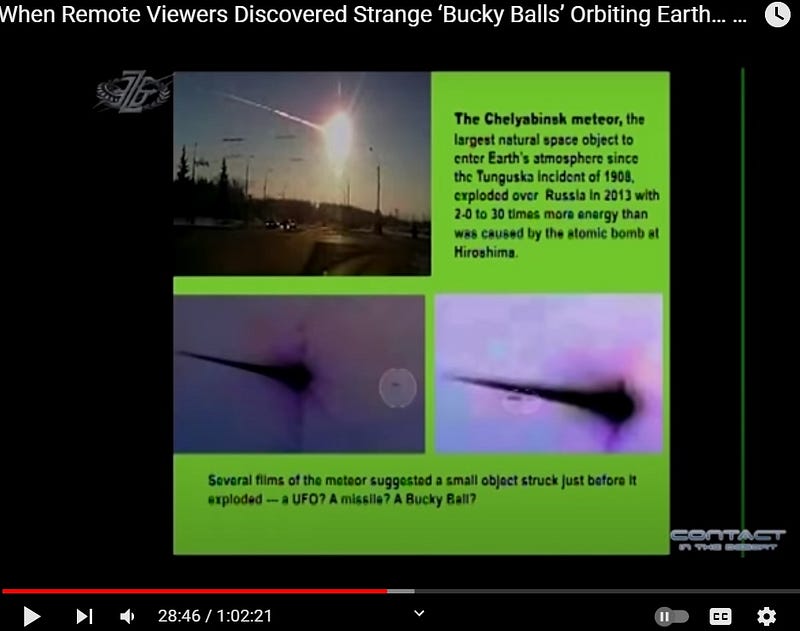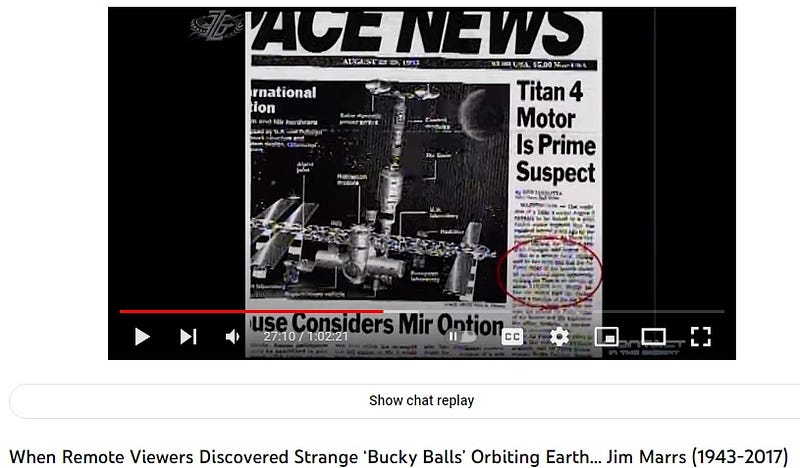UFOs and the Mystery of the Russian Meteor Event
Written on
The Peculiar Case of a Russian Meteor and UFO Interference
In the realm of unusual occurrences, the narrative surrounding the 2013 meteor over Chelyabinsk, Russia, raises eyebrows. It appears that there may have been a UFO presence involved in the incident—an idea that's both thrilling and hard to fathom.
Reflecting on the works of the late Jim Mars, a notable figure in UFO research, I was surprised to learn about Remote Viewing, a program that utilized psychic abilities for espionage. What caught my attention was the claim that our psychic operatives might have witnessed a UFO intercepting a ballistic missile at a staggering altitude of 110,000 feet—a detail I had never encountered in mainstream news reports. Furthermore, the suggestion that the Chelyabinsk meteor was possibly neutralized by a UFO leaves me both baffled and intrigued.

During a lecture by Jim Mars, familiar topics surfaced, including Operation Paperclip, which continues to evoke skepticism. The idea that such historical figures could have laid the groundwork for NASA, which we now rely on for space exploration, raises troubling questions about trust in these institutions.
As I ponder the trajectory of this discourse, it becomes evident that many markers on this journey lead us to a common conclusion shared by UFO enthusiasts: we are not alone in the universe.
My interest peaked when Mars brought up the Chelyabinsk meteor. Had it struck the earth directly, estimates indicate it could have devastated the region.
> At 9:20 AM local time on February 15, 2013, a meteor blazed through the skies over Chelyabinsk, producing an intense light brighter than the sun. It traveled approximately 200 miles before exploding, causing extensive damage, including over a thousand injuries primarily from shattered glass. Coincidentally, this event coincided with the close approach of asteroid 2012 DA14, though the two occurrences were officially deemed unrelated.
What’s the underlying narrative here? An asteroid breaching our satellite belt coinciding with a meteor event? The emphasis on their disconnection raises questions—was the asteroid even relevant to the majority of the population?
Additionally, claims emerged about possibly recovering fragments of the meteor—yet the uncertainty surrounding these findings is perplexing. While Dr. Avi Loeb has garnered attention for his quest to retrieve an interstellar meteorite from the ocean floor, the Chelyabinsk incident remains shrouded in ambiguity despite being well-documented.
In contrast, UFO sightings often receive little attention. Why did the image of a UFO from that meteor event not capture widespread media interest?
UFOs: A Reality Beyond Human Craft
While it may be easy to dismiss the connection between the asteroid and the meteor, the UFO footage speaks volumes. The question arises: what are the chances that these phenomena are unrelated?
With that in mind, let’s delve into the UFO images captured during the meteor event.

Can you spot it?

Here’s a clip from the Jim Mars lecture:

Multiple sources suggest that something may have struck the meteor—a UFO, a missile, or perhaps something else entirely.
One cannot help but question the feasibility of human technology intercepting such an object before impact. NASA's recent achievements in asteroid deflection took immense planning and effort. So, how can we believe we could down a meteor with ease?
The UFO narrative is compelling. Reports of UFOs neutralizing missiles and engaging in other military encounters have surfaced, yet mainstream coverage remains scarce.
What about the concept of 'buck balls'? Could these be part of an extraterrestrial defense mechanism? The US government's interest in "anomalous phenomena" predates even the Nimitz incident of 2004, suggesting a broader intrigue.
Psychic operatives have reported sightings of unidentified aerial phenomena, raising the possibility that we are under observation not just from Earth, but possibly from Mars and beyond.
UFOs appear to be deeply intertwined with human history, having appeared during significant events like WWII and in close proximity to military vessels, often without a clear explanation.
If UFOs are indeed intercepting meteors, should we reconsider our approach to these unidentified entities?

The idea that extraterrestrial intelligence has existed on Earth since before the dinosaurs raises even more questions. If these beings possess the technology to prevent disasters, why didn't they intervene during the meteor impact?
Theories abound—perhaps they had a hand in causing the event or chose to remain passive. The complexity of these mysteries leads us to ponder the implications of non-action versus direct intervention.
The only plausible explanation for inaction might involve time travel—preventing an asteroid impact could alter the course of human evolution itself.

The mysteries surrounding UFOs and extraterrestrial phenomena continue to confound us. If society thrives on enigmas, why do mainstream media outlets shy away from exploring these compelling narratives?
Ancient art depicting humans alongside dinosaurs suggests that our understanding of history may be flawed. Are we witnessing a deliberate obfuscation of knowledge?
The UFO saga is fraught with complexities, leaving us with more questions than answers. If these entities are genuinely protecting humanity, perhaps our response should be one of curiosity rather than hostility.
recommended:
Here's what we know about the fast-approaching asteroid 2012 DA14 and its trajectory toward our planet.
A detailed account of the Titan Groundhog Day launch failures.
Launch Failures: Titan Groundhog Day
Evidence of coexistence between dinosaurs and humans, as depicted in ancient Peruvian art.